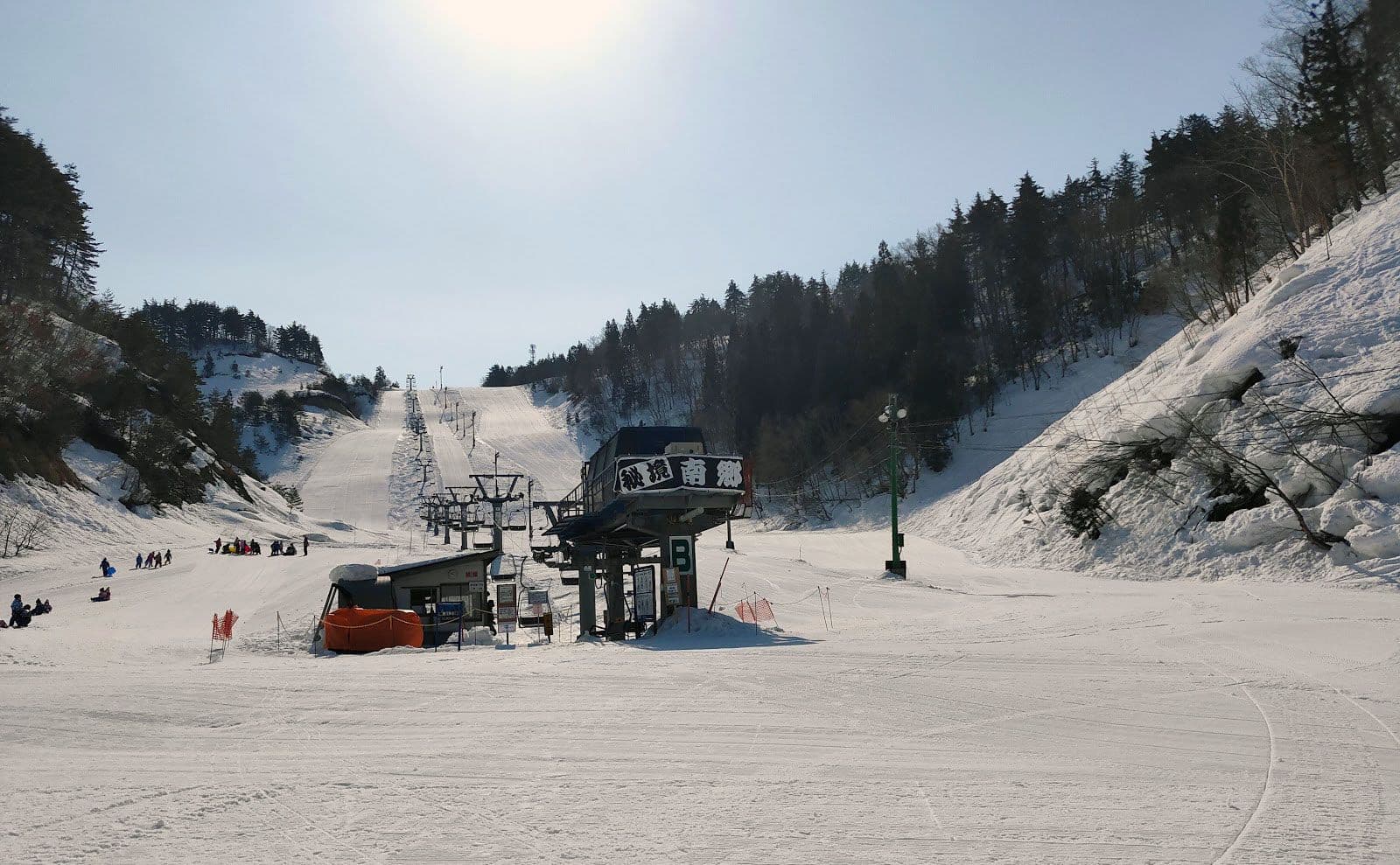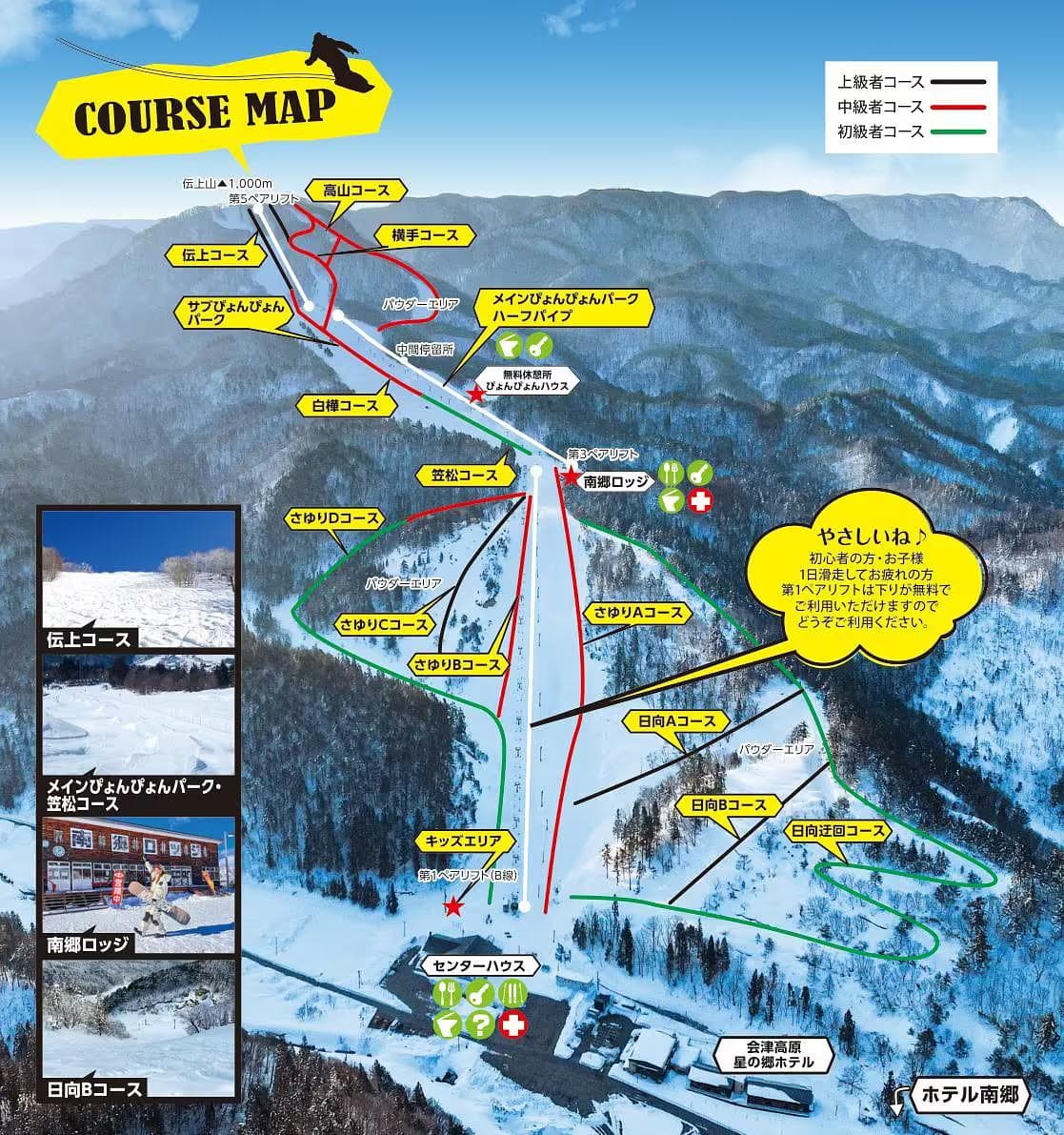Aizu Kogen Nango
Fall-line flow, soft storms, small-hill stoke

南郷
Easy rhythm, honest turns
Aizu Kogen Nango sits quietly in the Minamiaizu hills, far from the resort circus and close to the snow that matters. The setting is pure rural Tohoku — cedars, farm valleys, and a base area that feels like a community hub. On a cold morning the corduroy shimmers, the liftie gives you the nod, and you’re trenching clean arcs before the bus tours even find their poles. It’s not a mega-resort, and that’s the point. Everything is close, parking is hassle-free, and the day flows.
Weekdays are a gift. You’ll hear bar down clicks more than you’ll see a queue, and fresh grooming holds its bite for hours. When it resets, soft snow tucks onto the edges and into marked ungroomed strips, leaving secret stash pockets that last longer than you’d expect. Weekends bring local families and school groups, so plan early — first chair for carving and a late-morning coffee while the groms ride the magic carpet. Even then, traffic spreads fast and the upper chairs stay efficient.
Affordability is a big part of Nango’s charm. The lift ticket won’t sting, food in the lodge is hearty and fair, and pensions nearby keep costs sane for storm-chasing crews. English is limited, but the routine is obvious — ticket window, base lodge, clear trail maps — and staff are patient. If you’ve done a couple of Japan trips, you’ll have zero trouble navigating.
Families thrive here. The base zone is compact with easy green terrain, while intermediates get real progression on long fall-line blues. Advanced riders have enough gradient up high for legit carve sessions, plus a couple of designated soft-snow lanes when it’s been nuking. There’s no gate network and tree skiing is limited, which keeps patrol happy and the surface consistent — a trade-off that suits Nango’s keep-it-simple personality.
Resort Stats
- Vertical420m (1160m → 740m)
- Snowfall~8m
- Terrain 35% 50% 15%
- Tree Riding
- Lift Pass$26
- Lifts1 quad, 2 pair
- Crowds
- Out of Boundsnot allowed
- Night Skiing
- Family Friendly
- Trails10
- Skiable Area~55ha
- VibeLow-key Aizu local, carve culture
Trail Map

Powder & Terrain
Start on the upper quad for crisp fall-line groomers and dawn-patrol trenching, then pivot to the marked ungroomed strips and the outer margins of the main pistes once the sun lifts. Storms lay in boot-top deep refills along wind-sheltered edges, while wind buff smooths the steeper pitches after blustery nights. Boundaries are firm — no gate network and no sanctioned sidecountry — so respect the ropes, mine the rollers and side hits, and you’ll squeeze every drop from a reset day without fuss.
Who's it for?
Carvers, ex-racers, and anyone who gets a kick out of linking clean arcs down honest pitches will love Nango. Upper intermediates progress fast thanks to consistent grooming and friendly sightlines, while powder hounds still find mileage by working the in-bounds soft-snow strips after a reset. If your trip is all about glades, gate systems, and sidecountry, you’ll feel boxed in here — pair Nango with a day at Nekoma or Grandeco when you want more trees. Park rats should expect side hits and natural features more than big-feature parks.
Accommodation
Closest stays are classic pensions and minshuku in the Minamiaizu valleys. Expect toasty rooms, warm ofuro, and home cooking heavy on mountain vegetables. Hosts know the rhythm of the hill — they’ll push breakfast early when it’s a first chair kind of morning and send you out the door with a smile and a weather note.
If you’re chasing a moving snow line around Aizu, base out of a business hotel nearer to Aizu-Tajima or along the arterial roads toward the Kanto side. Think late check-in, coin laundry, no-nonsense breakfasts, and convenience stores for quick resupplies. It’s not glamorous, but it’s perfect for crews hoping to pivot between Nango, Takatsue, and Daikura as the storm track wiggles.
For a reset, look to a small onsen ryokan within a short drive. There are understated gems where steam rises through cedar in the evening and dinner leans into river fish, local sake, and winter hotpots. After a day of first chair to last chair, soaking under a cold sky with spindrift in the pines is as good as it gets.
Food & Après
On-mountain eats are exactly what you want on a cold day: curry rice, ramen, tonkatsu, and trays of karaage with crisp skin. Portions are worker-sized and prices are friendly. Coffee is basic but hot, and you’ll often find a sweet or two near the register.
Off the hill, small diners and family spots keep things simple and satisfying. Watch for sauce katsu-don, hand-cut soba, and warming nabe on the coldest nights. Après is mellow — more lot beers as the alpenglow fades than bar crawls — but if you crave a nightcap, grab local sake from a mom-and-pop store and keep it civilized back at the pension.
Getting There
From Tokyo, the straightforward drive heads up the Tohoku Expressway toward the Nasu-Shiobara area before rolling west into the Minamiaizu valleys. In clear conditions, plan ~3.5–4.5 hours depending on traffic. Once you’re off the highway the roads can glaze quickly — winter tires are non-negotiable and carrying chains is wise when it’s nuking.
Public transit works if you’re patient: ride Tobu or Aizu Railway to Aizu-Tajima, then connect by local bus into the resort corridor. Services can be sparse midweek, so build your day around the timetable rather than the other way around. If you’re stringing together an Aizu circuit — Nango, Takatsue, Daikura — a rental car with proper tires makes storm chasing far easier.
Japow Travel Tips
- Lift hours: Typical winter schedule is ~08:30–16:00. No night skiing — plan for early starts and long groomer sessions.
- Lift access / notable gates: Upper quad plus pair chairs cover the hill efficiently; no gate network and no sanctioned sidecountry.
- Avalanche / backcountry reality: This is an in-bounds program. Ropes are firm and ducking them can cost your pass.
- Weather & snow: Interior exposure keeps temps colder than coastal Honshu. Expect chalky hold between systems, wind buff after blowy nights, and free refills tucked along piste edges when it resets.
- Language & payments: Limited English; carry cash for pensions and small eateries. The ticket window often accepts cards, but don’t bank on it.
- Became popular in recent years: No — a steady local favorite serving Minamiaizu families and school groups.
- Prices around the resort: Cheap — lift price is friendly, food is fair, and pensions are excellent value.
- Crowd pattern: Light midweek with the odd race-club block; weekends see more families at the base while the upper chairs remain quick.
- Pairing ideas: Add Aizu Kogen Takatsue for more vertical, Aizu Kogen Daikura for additional carve terrain, and on colder cycles consider a day at Grandeco or Nekoma Mountain for tree options.
Verdict: Dawn patrol to last chair, no drama
Aizu Kogen Nango doesn’t chase headlines — it quietly delivers the kind of days you remember for the feel. Clean fall line, soft mid-winter snow, light crowds, and a warm, no-drama base scene make it a stellar stop on any Aizu road trip. If your idea of a good time is first chair, trenching corduroy, sneaking a few secret stash turns, and soaking in a rural onsen at dusk, Nango fits like your favorite board or a well-tuned pair of carvers.